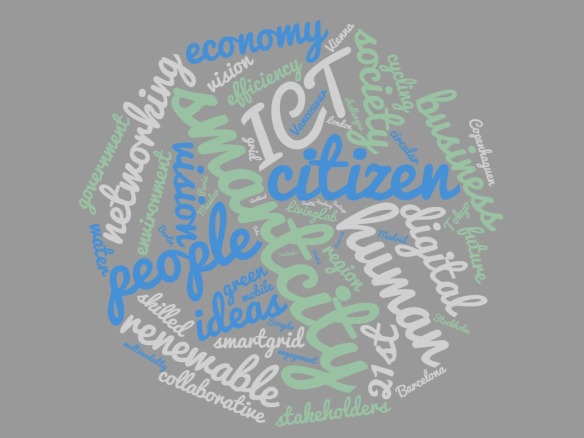They say a picture is worth a thousand words, in fact any idea, no matter how complex it is, can be easily conveyed with just a single image. Surely anyone of us did visual schemes in our student days to learn the concepts of any subject. Images go beyond languages, for instance, a red octagon on a street or road would make us stop immediately, regardless the text written into it. There are even commercial brands that exploit the power of images and replace their trademark name by their logo, which becomes a worldwide recognized symbol which identifies them universally.

The huge quantity of concepts involved in the smart city can result in a mesh. Image generated at WorldClouds.com
In this post I would like to share with you an image for the concept of smart city, my own vision based on the knowledge I have gained on this field, and which has allowed me to order in certain way the thematic complexity behind the construction and management of the 21st century city. It is a simple but effective image based on four core areas, strongly related among them, so that any service or actuation that make possible the smart city can be classified within one of them. These core areas are: environment, social (smart society), urban planning and ICT technologies.
Environment.
The smart city encourages the use of renewable energies and incites the responsible use of the natural resources such as water o materials like paper. Another issue that takes into account is air quality in cities so it promotes measures such as the creation of green areas or the encouragement for more sustainable mobility habits.
Social (smart society).
The 21st century society is characterized by being collaborative and organized as a network. Citizens want to participate in the management of the city and have the tools to do it, therefore administrative bodies open out onto them. On the other hand new “virtual” services that don’t require a physical space such as e-learning, e-health or e-banking emerge. The 21st century society is also known as the information society or the knowledge society, due to its great availability to access a huge amount of information sources and the high capacity to convert this information into knowledge.
Urban planning.
The way urban spaces are designed will define the usages citizens will give to them. These places should be thought so they promote habits that favorize the other core areas of the smart city. An important issue within this area is mobility, one of the big challenges that the 21st century city must face.
ICT technologies.
ICT technologies are, undoubtedly, the great enablers of the smart city since they provide the necessary tools to make possible an interchange of information that is immediate and ubiquitous, as well as the necessary tools to process this information and turn it into useful knowledge that makes more efficient the management of the city. They also provide a bidirectional communication channel which makes easier the relationship between city managers and their citizens as well as between citizens themselves.
In addition of these four core areas, it must be considered that the concept of smart city places citizens in the center of all the actions that are carried out. Any decision taken to develop de 21st century city looks for the benefits for its citizens. Moreover, the smart city engage them in its management and pay attention to their opinions.
Tetrahedron is a geometrical figure composed of four vertices linked together, each one of them is directly connected to the other three, so it seems to me a geometrical figure that suits well to the concept of smart city. It is a 3D figure, rather complicated to represent in 2D, but with a volume that will be useful to place into it a sphere representing the citizens, right in the center of the tetrahedron.
The ideal smart city can be considered as the one that fully develops the four core areas giving the same importance to each of them. In this case we would see a regular tetrahedron with a perfectly centered sphere inside, tangent to the four faces of the tetrahedron, the more and better developed would be the smart city concept in a urban space the bigger would be this figure. But the ideal rarely exists, so the most common situation will be that in which one of the core areas predominates over the others; but beware, if one of the core areas is not developed there won’t be any volume, there won’t be any sphere and, therefore, there won’t be any smart city.

Visualization of the concept of smart city, a tetrahedron containing a sphere
The smart city seen as a tetrahedron with a sphere inside. A bizarre image? An original one? A nonsense one? This image helped me to understand the concept of smart city and the importance of take into account all the aspects involved, paying attention to not forget any of them since in that case the smart city would not be possible. How about you, have you done the exercise of visualize the smart city? Which image do you associate to it? I will be pleased to know your opinion.

Pingback: A tale about the Bit (aka Smart) City | The Bit City